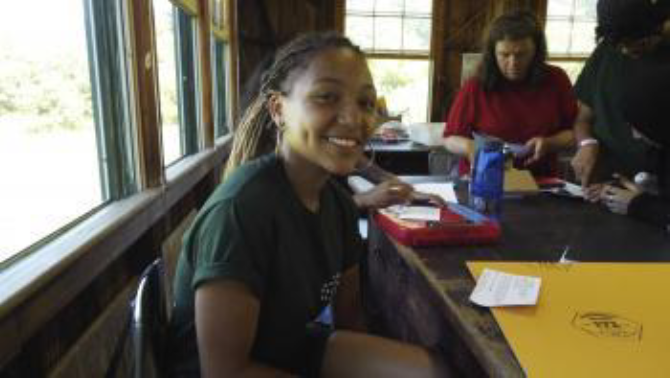Summer Ecology Program Featured in Local News
Our Summer Ecology Program was a great success as always and gained recognition in a local newspaper for its unique characteristics. Filled with energy, curiosity, and drive, 14 of our students ventured deep into the woods, ready to learn and participate in original field research. After arriving at the Yale Camp in the Great Mountain Forest, our students connected to the surrounding environment, immersed themselves in their research and built strong ties of friendship. Each student had been recommended by a science teacher, guidance counselor, or principal for their proficiency and interest in science; they were able to further their passion at our program as a result of their hard work and enthusiasm. Please read below!

INTO THE WOODS, FOR CITY SCIENCE STUDENTS AT YALE CAMP
By Mari Cullerton and Patrick L. Sullivan
07/28/2016 – Falls Village

Deasia Ratcliff of the Bronx was one of a group of New York City high school students who spent two weeks at the Great Mountain Forest in July. Her group studied microhabitats — specifically, an eastern hemlock tree. Photo by Patrick L. Sullivan
FALLS VILLAGE — The first thing the 14 New York City high school students had to do on arriving at the Yale Forestry camp in Great Mountain Forest (GMF) was surrender their cell phones.
Two weeks later, they all had survived.
Judith Rivkin, Executive Director of Christodora Foundation in New York City, was on hand Thursday, July 21, for the last day of camp and the presentation of research projects — not to mention the return of the phones.
The foundation helps urban high school students build leadership and academic skills through environmental education.
The Summer Ecology Program allows students to explore forest ecosystems and requires them to conduct original field research. Rivkin described the program as a “youth program through nature and science.” She explained that the students, 16 and 17 years old, are from New York City. For most, it was their first experience in the woods.
Rivkin added that the teenagers did not exhibit cell-phone withdrawal symptoms.
Instead, they were sociable. One student said, “We were like new people after 20 minutes.” (And the cell phones probably wouldn’t work out in the woods anyway.)
The students began their two-week stay by hiking around GMF with forest manager Jody Bronson and his staff, observing things. Then, after breaking up into small groups, the students brainstormed dozens of ideas for research projects.
Jennifer Dahlstrom, who is the chairman of the science department at the Institute for Collaborative Education in New York, said the teams had to work through their brainstorming results and come up with experiments that could be accomplished over the two weeks and with limited resources.
The students did take a trip to the Norfolk Library to do some research. But the bulk of the work was done on-site. Dahlstrom said the process “showed a good science background” on the part of the students.
The students were assisted by Christodora alumni. Tavion Williams of Brooklyn was the outdoor education coordinator. Adrian Castro from the Bronx has been involved with Christodora since age 12 and is now working on a Ph.D. at Rensselaer Polytechnic Institute.
One team, the Black Bears, boiled their observations down to the question of how terrain and elevation affect plant growth. They then refined the concept further, to calculating the effects of elevation on concentrations of nitrogen, phosphorus, potassium and water. The Black Bears took soil samples at elevations ranging from 1,400 to 1,700 feet and used a soil testing kit. To determine water concentrations, the group put the soil in an oven and waited for the water to evaporate.
One conclusion: Phosphorous levels increase with elevation. The team thought this was probably because the element “comes a lot from rock.”
During their presentation, the Black Bears were fairly hard on themselves, saying that their experiment was not perfect. They suggested ways the procedure could be improved — including collecting samples in one day to prevent varying weather from affecting the data. For example, rain could wash away nutrients, increase water concentrations and change pH. The group also decided that they should have taken into account the fauna near the samples, because animals can change the soil around them.
The group Girls Who Rock studied insect diversity in varying locations.
They found an uprooted, but not completely downed, eastern hemlock. They wanted to determine whether or not the tree provides a better microhabitat than the area surrounding it.
The group collected 40 insects, both ground and flying species, from near the tree and from the surrounding area. To ensure that their data were unbiased, they threw a glove in the air and put a trap where it fell. They found that, on average, there were more insects near the uprooted hemlock than in the surrounding area.
The group determined that dead trees are beneficial to the environment and provide valuable habitat not only for insects but also for other animals, such as bears (they found evidence that a bear had been staying in the area where the roots of the tree had formed a sort of wall).
Matt Scholl, Christodora program director, came to watch the presentations. “Our mission is to have our youth thrive,” he said, “with an emphasis on building confidence and social skills.” “We are giving high school students who don’t really get this type of science in school hands-on work.”
One of the Girls Who Rock, Deasia Ratcliff, 16 and from the Bronx, has been in the program since the sixth grade. She said the program “isn’t all work, so it’s more fun.” Deasia used the difference between her urban background and the decidedly rustic GMF setting to good effect during the group’s explanation of how to trap insects for study. “It’s just like the traps you use if you have roaches in your house,” she said.
“I’m just saying,” she added in response to the laughter.

